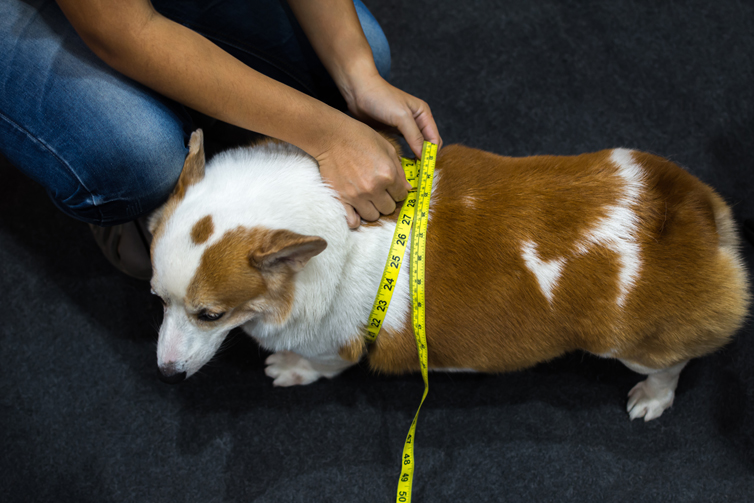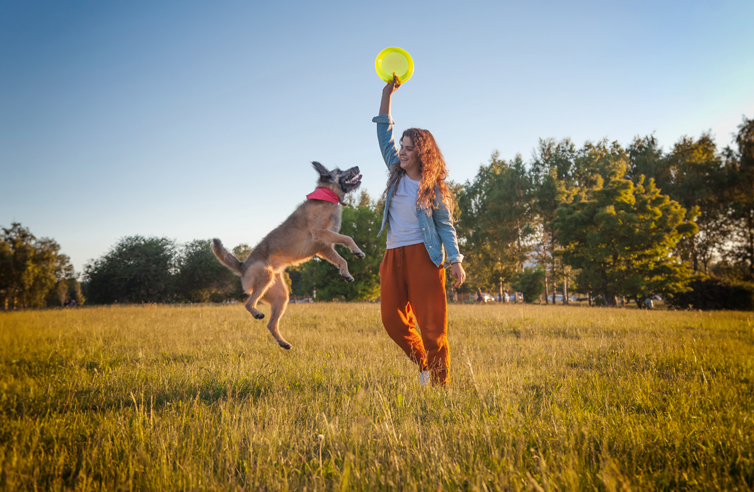How do I know if my dog’s overweight?
A few extra kilograms on your dog may not seem to be a problem but extra weight can mean that your dog may develop health issues and may have a shorter life expectancy. In fact, veterinarians say that obesity is one of the most common problems that they encounter in their practices.
Many issues can affect weight gain. Some factors are beyond our control, such as breed and age, but diet, one of the main causes of excess weight, can be controlled. Who doesn’t like to give their doggie treats regularly or give him bits of food from their plate, believing that this can’t harm him? However, all those bits, added up, may be responsible for your dog being overweight.
HEALTH AND WELLNESS

How do I know if my dog’s overweight?
It’s simple, look and feel! Here’s what you can do:
Side view: Look at your dog’s side profile and ask yourself: Does the tummy droop and sway? Is the waistline sagging? If so, your dog could be overweight. The lower profile of the tummy should be higher than the ribcage and the tummy should not hang below. If so, this could mean that your dog is overweight.
Body Shape: Have a bird’s eye view by standing above your dog and looking down. Your dog’s body should be curved like an hourglass, bending in a little behind the ribs. Your dog is probably overweight if his/her shape from above is round or oval.
Ribs and Spine: Feel along your dog’s ribcage. If you can feel his/her ribs under the skin then your dog’s weight is probably fine. Feel along the spine – your dog could be underweight if the bones are protruding.
Fat Pads
While playing with your dog, see if you can feel pads of fat on the tops of the hips or between the legs. If so, then he is probably overweight, as these pads are an important sign of excess weight.
Your dog’s behaviour
Watch how your dog reacts to a bowl of food compared to a thrown ball. If he/she goes for the food, it could suggest a weight issue. During exercise, a plump pooch may find walking and breathing difficult.
Overweight dogs need help!
Health issues often affecting overweight dogs:
- Diabetes
- Breathing problems
- High blood pressure
- Kidney problems
- Heart issues
- Problems with immune system
- Mobility problems – Arthritis and other joint problems
- Cancer – certain types
- Shorter life expectancy
Weight and calories
Start with a visit to your vet who will probably compare your dog’s weight and body to a ‘Body Condition Score Chart’ which scores dogs’ shape and body type. On a scale of 1-9, from extremely underweight to obese, with ‘target body condition’ at around 4/5, your dog will be given a rating. Breed can of course affect ideal weight. Greyhounds are naturally slim, where Labradors tend to put on weight.
Age also affects how ‘ideal’ weight is determined. Pups need more calories than adults and this amount is sometimes reduced when the pup is fully grown. Weight gain can start as the calories from food overtake the calories burned with exercise.
When the adult dog gets older, he/she is more likely to put on weight. Food should be reduced as the dog’s metabolism starts to slow down.
A weight-loss plan
You and your vet will need to make a reasonable plan, if your dog is in fact overweight, to reduce calorie intake and increase exercise to burn more calories.

Exercise
Walking is the best way to get your dog to exercise. Start slowly, with 10-15 minutes a day, and gradually increase the speed and length of walks. Some vets say that your dog can walk for up to 2 hours per day, depending of course on factors such as age and breed. Remember to praise your dog and give him/her lots of positive attention, which will increase the likelihood of poochie finding the walks enjoyable and to be eager to walk again.
Diet plan
You will need to reduce daily calories and portion sizes whilst making sure tubby buddy gets the required nutrition. Making food available at all times (‘free-feeding’) is probably not a good idea and treats should be few and far between.
To reduce the risk of health issues associated with excess weight, making basic changes to the diet and increasing exercise will help to bring your dog’s weight down. It is never too late.
Subscribe to our Newsletter
Get to know your furry friend better! Sign up for all things dog- or cat-related.
The Hairy Facts about the dreaded hairball
12 April 2021
Help! My dog’s barking mad! Volume 2
12 April 2021
Your Itchy, Scratchy Cat – All About Cat Skin Problems
12 April 2021
The Dog’s Diet: A Bone of contention?
01 April 2021
Mango Fly Worms: How to Spot and Eliminate them
Posted on November 28,2019
Managing Mange And Mites In Your Dog
Posted on June 11,2018
Why Do Cats Purr and How? Learn What Your Cat Is Saying
Posted on October 14,2020
How to Get Rid of Ear Mites in Dogs
Posted on November 06,2019









